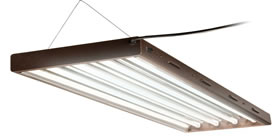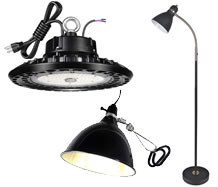|
Fluorescent
Plant Grow Lights 
 Until
recently, fluorescent grow lights have had a low output and have been too big
and bulky to be of much use as a grow light for anything more than starting seedlings.
T5 full spectrum fluorescent lights have changed that. At 75 to 90 lumens
per watt, these lights are energy efficient and extremely effective especially
when used in numbers. Fluorescent grow lights also have better color rendering
properties (more of the light emitted is used by the plant) and produce much less
heat than incandescent and HID grow lights. This allows them to be placed closer
to plants (within a few inches) greatly decreasing lumen loss from the bulb to
the plant. It is recommended that these lights be placed no more than a couple
feet from the plants for best results. View
T5 fluorescent tube grow lights Until
recently, fluorescent grow lights have had a low output and have been too big
and bulky to be of much use as a grow light for anything more than starting seedlings.
T5 full spectrum fluorescent lights have changed that. At 75 to 90 lumens
per watt, these lights are energy efficient and extremely effective especially
when used in numbers. Fluorescent grow lights also have better color rendering
properties (more of the light emitted is used by the plant) and produce much less
heat than incandescent and HID grow lights. This allows them to be placed closer
to plants (within a few inches) greatly decreasing lumen loss from the bulb to
the plant. It is recommended that these lights be placed no more than a couple
feet from the plants for best results. View
T5 fluorescent tube grow lights
The standard T12 bulbs full spectrum tubes are fine for starts and seedlings
and are popular for growing low-light plants like herbs and African violets. These
lights are inefficient and are be replaced with high efficiency T5 lights which
are a better light source for flowering and budding applications as well. View T5 fluorescent grow lights
LED
Plant Grow Lights 
 LED
grow lights are the newest lighting option for plants. They have come a long ways
from the days of blue and red bulbs and are now available in full spectrum natural
looking lights that blend in with the surroundings. LED lights are also among
the most efficient and coolest running grow lights available. We offer several LED grow light options including LED floor lamps, clamp-on lights, LED hanging grow lights, and LED bulbs for your existing light fixturs.
They perform well and are long lasting while using less
electricity. View LED grow lights LED
grow lights are the newest lighting option for plants. They have come a long ways
from the days of blue and red bulbs and are now available in full spectrum natural
looking lights that blend in with the surroundings. LED lights are also among
the most efficient and coolest running grow lights available. We offer several LED grow light options including LED floor lamps, clamp-on lights, LED hanging grow lights, and LED bulbs for your existing light fixturs.
They perform well and are long lasting while using less
electricity. View LED grow lights
HID (High
Intensity Discharge) Plant Grow Lights 
HID lighting is the most efficient way to convert electricity
into light that is available to the consumer. There are two types of HID grow
lights used for horticultural lighting:
Metal
Halide - MH
Metal halide bulbs produce an abundance of light in the blue spectrum. This color
of light promotes plant growth and is excellent for green leafy growth and keeping
plants compact. It is the best type of light to be used as a primary light source
(if no or little natural sunlight is available). The average lifespan is about
10,000 cumulative hours. The bulb will light up beyond this time but due to the
gradual decline of light, it is not worth your while to wait for the bulb to finally
burn out. If you compare their lumen (brightness) per unit of energy consumed,
metal halides produce up to 129 lumens per watt compared to 42 lumens per watt
with standard fluorescent lights and 18 lumens per watt for standard incandescent
bulbs. View MH & HPS grow lights
High Pressure Sodium - HPS
High pressure sodium bulbs emit an orange-red glow. This band of light triggers
hormones in plants to increase flowering/budding in plants. They are the best
grow lights available for secondary or supplemental lighting (used in conjunction
with natural sunlight). This is ideal for greenhouse growing applications.
Not only is this a great flowering light, it has two features that make it a more
economical choice. Their average lifespan is twice that of metal halides, but
after 18,000 hours of use, they will start to draw more electricity than their
rated watts while gradually producing less light. HPS bulbs are very efficient.
They produce up to 140 lumens per watt. Their disadvantage is they are deficient
in the blue spectrum. If a gardener were to start a young plant under a HPS bulb,
she/he would see impressive vertical growth. In fact, probably too impressive.
Most plants would grow up thin and lanky and in no time you will have to prune
your plant back before it grows into the light fixture. The exception to this
is using HPS grow lights in a greenhouse or in conjunction another light source
that emits light in the blue spectrum. Light sources that have a high output in
the blue spectrum like sunlight and MH grow lights offset any stretching caused
by HPS bulbs. View MH & HPS grow lights
.
Incandescent
Plant Grow Lights 
 These
lights are the most inexpensive to purchase but are also the most inefficient
and a poor source of light for plants. At best they can provide supplemental light
to individual house plants. Incandescent lights have a low lumen output per watt
compared to HID and fluorescent grow lights. New smaller LED grow lights like
our Green Thumb system produce as
much light as a 200 watt incandescent bulb, and more of the light is used by the
plant. This type of bulb will pay for itself in energy savings the first 60 days
of use. These
lights are the most inexpensive to purchase but are also the most inefficient
and a poor source of light for plants. At best they can provide supplemental light
to individual house plants. Incandescent lights have a low lumen output per watt
compared to HID and fluorescent grow lights. New smaller LED grow lights like
our Green Thumb system produce as
much light as a 200 watt incandescent bulb, and more of the light is used by the
plant. This type of bulb will pay for itself in energy savings the first 60 days
of use.
|